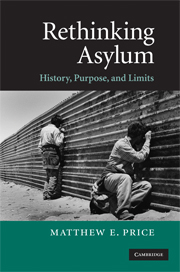Book contents
- Frontmatter
- Contents
- Acknowledgments
- Introduction
- Chapter 1 Recovering Asylum's Political Roots
- Chapter 2 Promoting Political Values through Asylum
- Chapter 3 What is “Persecution”?
- Chapter 4 Persecution by Private Parties
- Chapter 5 Asylum, Temporary Protection, and the Refugee Policy Toolkit
- Chapter 6 Restrictions on Access to Asylum
- Conclusion
- Bibliography
- Index
Chapter 1 - Recovering Asylum's Political Roots
Published online by Cambridge University Press: 26 January 2010
- Frontmatter
- Contents
- Acknowledgments
- Introduction
- Chapter 1 Recovering Asylum's Political Roots
- Chapter 2 Promoting Political Values through Asylum
- Chapter 3 What is “Persecution”?
- Chapter 4 Persecution by Private Parties
- Chapter 5 Asylum, Temporary Protection, and the Refugee Policy Toolkit
- Chapter 6 Restrictions on Access to Asylum
- Conclusion
- Bibliography
- Index
Summary
Historiography plays an important role in debates over the proper conception of asylum. Critics of the persecution requirement have widely assumed it to be a Cold War artifact without any historical basis – a deviation from a humanitarian tradition that addressed the needs of the asylum seeker without making any judgment about the actions of the origin state. The persecution requirement, it is claimed, is a “product of recent Western history,” framed to cast a spotlight on Soviet deficiencies with regard to political rights, while leaving in the shadows Western deficiencies regarding “socio-economic human rights.” On this view, the persecution requirement distorted asylum into a political instrument to be wielded against the Soviets at the cost of addressing the urgent needs of refugees.
Gervase Coles, for example, says that the persecution requirement was “specifically devised for a particular geographic problem at a particular time” – namely post-war Europe. It was, he writes, “adopted as being the essential characteristic of the new refugee in the belief that this would satisfactorily define European asylum seekers, the majority of whom were from Eastern Europe … Both in its conception, and in practice, the ad hoc and partisan character of this approach was incontrovertible.” Jerzy Sztucki states that “the Convention with its definition is sometimes described as a Cold War product, ‘Eurocentric’ and, if only for these reasons, obsolete.” James Hathaway labels it “incomplete and politically partisan.”
- Type
- Chapter
- Information
- Rethinking AsylumHistory, Purpose, and Limits, pp. 24 - 68Publisher: Cambridge University PressPrint publication year: 2009
- 2
- Cited by



